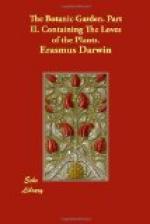There are many other instances of spontaneous movements of the parts of vegetables. In the Marchantia polymorpha some yellow wool proceeds from the flower-bearing anthers, which moves spontaneously in the anther, while it drops its dust like atoms. Murray, Syst. Veg. See note on Collinfonia for other instances of vegetable spontaneity. Add to this, that as the sleep of animals consists in a suspension of voluntary motion, and as vegetables are likewise subject to sleep, there is reason to conclude, that the various actions of opening and closing their petals and foliage may be justly ascribed to a voluntary power: for without the faculty of volition, sleep would not have been, necessary to them.]
[Illustration: Hedysarum gyrans.]
Clasp’d
round her ivory neck with studs of gold
Flows
her thin vest in many a gauzy fold;
O’er
her light limbs the dim transparence plays,
340 And the fair form, it seems to hide, betrays.
Where
leads the northern Star his lucid train
High
o’er the snow-clad earth, and icy main,
With
milky light the white horizon streams,
And
to the moon each sparkling mountain gleams.—
345 Slow o’er the printed snows with silent
walk
Huge
shaggy forms across the twilight stalk;
And
ever and anon with hideous sound
Burst
the thick ribs of ice, and thunder round.—
There,
as old Winter slaps his hoary wing,
350 And lingering leaves his empire to the Spring,
Pierced
with quick shafts of silver-shooting light
Fly
in dark troops the dazzled imps of night—
[Burst the thick rib of ice. l. 348. The violent cracks of ice heard from the Glaciers seem to be caused by some of the snow being melted in the middle of the day; and the water thus produced running down into vallies of ice, and congealing again in a few hours, forces off by its expansion large precipices from the ice-mountains.]
“Awake,
my Love!” enamour’d MUSCHUS cries,
“Stretch
thy fair limbs, resulgent Maid! arise;
355 Ope thy sweet eye-lids to the rising ray,
And
hail with ruby lips returning day.
Down
the white hills dissolving torrents pour,
Green
springs the turf, and purple blows the flower;
His
torpid wing the Rail exulting tries,
360 Mounts the soft gale, and wantons in the skies;
Rise,
let us mark how bloom the awaken’d groves,
And
’mid the banks of roses hide our loves.”
[Muschus. l. 353. Corallinus, or lichen rangiferinus. Coral-moss. Clandestine-marriage. This moss vegetates beneath the snow, where the degree of heat is always about 40; that is, in the middle between the freezing point, and the common heat of the earth; and is for many months of the winter the sole food of the rain-deer, who digs furrows in the snow to find it: and as the milk and flesh of this animal is almost the only sustenance which can be procured during the long winters of the higher latitudes, this moss may be said to support some millions of mankind.




